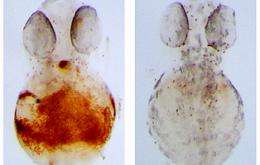Scientists Discover New Molecular Scissors That Cut the Tiniest Genes

(PhysOrg.com) -- A team of Yale University scientists has discovered a previously unknown type of molecular scissors that can tailor micro-RNAs, tiny snippets of genetic material that play a key role in regulating many of life's functions.
The team also found that the absence of these molecular scissors, or the micro-RNAs they create, could trigger anemia in mice and in zebrafish, the team reports online in the May 6 issue of Science Express.
“We are still just beginning to scratch the surface in our understanding of small RNAs,” said Antonio J. Giraldez, the Lois and Franklin H. Top, Jr. Yale Scholar in the genetics department of the Yale School of Medicine and senior author of the study. “This discovery really opens the door to finding new families of these RNAs that influence many forms of biological activity.”
In last decade, scientists have come to realize the great importance of small RNAs in regulating gene activity. Micro-RNAs are the smallest genes known, with as few as 22 building blocks or nucleotides. Most genes average more than 1000 nucleotides. Unlike most genes that are encoded as DNA and produce proteins, these tiny genes act by controlling much larger messenger RNAs, which carry the protein-making instructions of the DNA. Although micro-RNAs account for only about four percent of all genes, each one can regulate hundreds of genes.
“Recent finding have told us that micro-RNAs have deep implications not only in how humans and animals are made, but in the development of human diseases,” Giraldez said.
Up until now, it was thought that the creation of these microRNAs depended upon the presence of an enzyme called Dicer, which acts like a molecular scissors and helps to cut microRNAs to the right size and shape. Giraldez’s lab, in conjunction with researchers at Cold Spring Harbor, upended that dogma when they discovered important micro-RNA activity could take place without Dicer. The team created a micro-RNA that appears to be essential to the creation of red blood cells in both zebrafish and in mice by using a different enzyme called Argonaute 2.
Giraldez noted that the conservation of this mechanism in all vertebrates, maintained across 400 million years of evolution, suggests it plays an important role in survival.
“There is an immense, vast sea of small RNAs out there, and it is difficult to sort out what is junk from what is functional,” Giraldez said. “With this new molecular scissors, we have another tool to find small RNAs that are important to life, that activate genes in disease, and may be important in developing new therapeutics.”
Other Yale researchers contributing to the paper were Daniel Cifuentes, Huiling Xue, David, W. Taylor, Heather Patnode and Shrikant Mane. Other authors on the paper are from Cold Spring Harbor Laboratory, Kobe University, Stony Brook University, the University of Massachusetts Medical School and the University California, Berkeley.
Provided by Yale University

















